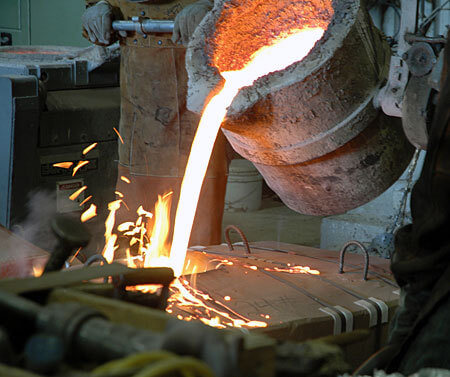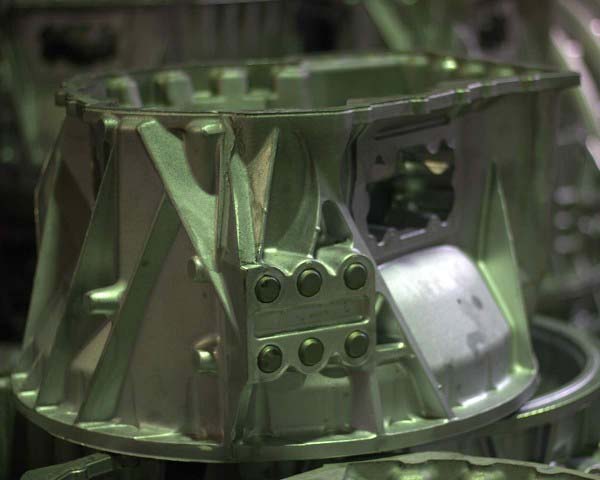Common Challenges in Precision aluminum casting and Practical Solutions Explained
Aluminum Casting Explained: Trick Realities and Insights for Market Professionals
Aluminum casting works as an important process in modern-day production, shaping elements across different fields. Its varied techniques, such as sand and die casting, deal with different manufacturing requirements. The unique residential or commercial properties of aluminum alloys enhance their applicability, yet tests remain in preserving quality and effectiveness. Understanding these elements is essential for sector specialists. What are the most recent innovations and best techniques that can additionally optimize this process?
Summary of Aluminum Casting Processes

Crucial element of aluminum casting procedures consist of the preparation of mold and mildews, which might be made from sand, metal, or ceramic materials, relying on the planned use. In addition, temperature control is important to assure proper melting and solidification of aluminum.
The casting process permits detailed styles and can achieve high degrees of dimensional precision. As soon as cooled, the spreadings might go through completing procedures such as machining or surface area treatment to fulfill particular performance requirements. Overall, aluminum casting works as a flexible production technique, efficiently satisfying the varied demands of different markets.
Kinds Of Aluminum Casting Methods
In the domain of aluminum casting, numerous methods are utilized to accomplish different results. Sand casting methods supply adaptability and cost-effectiveness for complicated shapes, while die casting processes provide high precision and efficiency for mass production. Recognizing these methods is crucial for selecting the proper approach based upon job requirements.
Sand Casting Techniques
Sand casting techniques represent a basic approach in aluminum casting, where sand is made use of as a mold and mildew material to form liquified metal. This procedure includes developing a pattern from the preferred component, which is after that put in a sand blend to develop a mold. The sand is compressed around the pattern, and after elimination, it produces a tooth cavity in the shape of the component. Molten aluminum is poured right into this tooth cavity, allowing it to strengthen and cool down. One considerable benefit of sand casting is its convenience; it can accommodate big components and complex shapes. In addition, the products utilized are fairly inexpensive, making it an accessible option for various manufacturing applications in the aluminum sector.
Die Casting Processes
Die casting processes are a noticeable technique for shaping aluminum parts, utilizing high-pressure strategies to force liquified metal right into specifically engineered molds. This procedure is especially preferred for its ability to generate complicated forms with limited resistances and a smooth finish. There are two primary types of die casting: hot chamber and cool chamber. Hot chamber die casting appropriates for metals with low melting factors, enabling for faster production rates. Alternatively, cool chamber die casting is optimal for greater melting point steels, needing a separate melting heater. Both techniques boost effectiveness and decrease product waste, making them crucial in vehicle, aerospace, and consumer goods industries. Recognizing these processes assists experts choose one of the most proper strategy for their specific applications.
Product Feature of Aluminum Alloys

Strength and Durability
Stamina and resilience are crucial attributes of aluminum alloys that make them suitable for numerous casting applications. These materials show a desirable strength-to-weight proportion, permitting for the development of light-weight yet robust elements. When it come to tensile strength, particular aluminum alloys can be crafted to hold up against considerable lots without flawing. This home is specifically essential in sectors such as aerospace and automotive, where performance and safety and security are critical. Additionally, aluminum alloys frequently keep their mechanical properties under diverse temperature conditions, ensuring constant efficiency. The inherent ductility of these alloys likewise allows for reliable shaping during the casting process, making it less complicated to produce complex geometries. On the whole, the strength and resilience of aluminum alloys contribute substantially to their widespread usage in advanced applications.
Deterioration Resistance Characteristics
While aluminum alloys are valued for their stamina and light-weight residential or commercial properties, their rust resistance is another crucial attribute that improves their viability for various applications. Aluminum normally forms a protective oxide layer when revealed to dampness, which aids to avoid more oxidation. This inherent residential or commercial property makes aluminum alloys especially valuable in settings vulnerable to rust, such as aquatic and commercial settings. In addition, different alloy structures can affect resistance levels, with certain alloys specifically engineered to enhance this particular. Treatments like plating can further enhance deterioration resistance by thickening the oxide layer. Comprehending the deterioration resistance of aluminum alloys is essential for sector specialists when choosing materials for tasks calling for resilience and durability in difficult settings.
Benefits of Aluminum Casting in Manufacturing
Aluminum casting offers various advantages in manufacturing, making it a favored selection for numerous industries. One see here now substantial advantage is its light-weight nature, which contributes to decreased transport expenses and improved energy effectiveness in end items. Aluminum's exceptional thermal and electric conductivity boosts functionality in applications needing warmth dissipation or electrical conduction.
The this content material's ability to be cast into detailed forms enables style versatility, reducing the need for additional machining processes. In enhancement, aluminum casting exhibits premium rust resistance, bring about longer item life-spans and lower upkeep prices.

Common Applications of Aluminum Castings
The flexibility of aluminum casting allows its prevalent usage throughout different sectors. Usual applications consist of automobile components, where lightweight and corrosion-resistant parts, such as engine blocks and transmission real estates, improve automobile efficiency. In the aerospace market, aluminum spreadings are used for structural parts, offering strength without adding substantial weight.
In addition, the electric market benefits from aluminum castings in manufacturing enclosures and warmth sinks, where thermal conductivity is important. The durable goods field likewise includes aluminum spreadings in items like pots and pans, furnishings, and decorative things, integrating looks with functionality.
The building industry utilizes aluminum castings for architectural elements, window frameworks, and components, which provide sturdiness and style flexibility. On the whole, the varied applications of aluminum castings underscore their value in modern-day manufacturing, adding to advancements in efficiency and item design throughout several fields.
Innovations and Technological Innovations
As markets continue to advance, developments in aluminum casting technology are changing manufacturing processes and item capacities. Advancements in 3D printing and additive production have actually made it possible for the development of complicated geometries that were previously impossible to attain with traditional approaches. These innovations enable for rapid prototyping, decreasing preparations and expenses.
In addition, improvements in mold layout and products have actually improved the casting process by increasing effectiveness and find more lowering waste. The integration of wise manufacturing strategies, such as IoT tools and real-time data analytics, permits much better tracking and optimization of manufacturing specifications, leading to greater top quality outputs.
Moreover, growths in aluminum alloys provide enhanced strength, deterioration resistance, and lightweight buildings, dealing with the expanding demands in automobile and aerospace sectors. Collectively, these innovations are not just enhancing performance but likewise satisfying the extensive criteria of modern-day design applications.
Best Practices for Quality Assurance in Aluminum Casting
Making certain top quality outputs in aluminum casting requires adherence to ideal techniques that incorporate various phases of the manufacturing process. First, complete product examination is crucial to validate the quality of aluminum alloys made use of, as impurities can greatly impact the end product. Implementing specific melting and pouring techniques reduces issues; maintaining ideal temperatures prevents oxidation and advertises harmony.
Mold and mildew style plays a vital function; using computer-aided style (CAD) can boost accuracy and decrease human mistake. Routine tracking of the cooling procedure is vital to prevent bending and contraction. In addition, utilizing non-destructive screening approaches, such as ultrasonic or X-ray examinations, aids identify interior problems without harming the elements.
Developing a feedback loop with drivers and designers promotes constant renovation, guaranteeing that high quality control steps progress alongside technical developments. By following these finest techniques, makers can enhance the integrity and efficiency of aluminum castings.
Frequently Asked Inquiries
What Are the Ecological Influences of Aluminum Casting?
The ecological impacts of aluminum casting consist of significant energy intake, greenhouse gas discharges, and potential water air pollution from shop procedures. Additionally, bauxite mining for aluminum ore can lead to environment devastation and soil destruction.
Exactly How Does Aluminum Casting Compare to Various Other Steel Casting Processes?
Aluminum casting typically provides benefits in light-weight elements and corrosion resistance compared to other processes, such as iron or steel casting, which may give better stamina but result in heavier and much less corrosion-resistant products. - Precision aluminum casting
What Are Common Defects in Aluminum Castings and Their Reasons?
Typical flaws in aluminum spreadings consist of porosity, shrinkage, and incorporations. Reasons usually originate from improper pouring techniques, inadequate mold and mildew design, or contamination of the molten steel, influencing the end product's honesty and efficiency.
What Security Preventative Measures Should Be Taken Throughout Aluminum Casting?
Throughout aluminum casting, crucial safety precautions consist of using protective gear, making certain appropriate ventilation, maintaining a clean office, handling molten metal with treatment, and complying with established protocols to decrease threats of burns, breathing dangers, and mishaps.
Just How Can I Enhance the Effectiveness of My Aluminum Casting Workflow?
To improve performance in aluminum casting operations, one need to optimize mold design, simplify product handling, use automated processes, conduct routine maintenance on devices, and purchase employee training to enhance skills and performance.
Numerous methods exist, aluminum casting incorporates several primary processes that provide to different applications and requirements. Secret aspects of aluminum casting procedures consist of the preparation of mold and mildews, which may be made from sand, steel, or ceramic products, depending on the intended use. Sand casting techniques represent a fundamental approach in aluminum casting, where sand is utilized as a mold material to shape molten steel. As industries continue to advance, advancements in aluminum casting modern technology are changing production processes and item capacities. Making certain premium outcomes in aluminum casting calls for adherence to finest methods that include numerous phases of the manufacturing process.